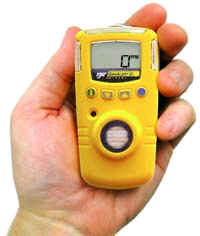Researchers in Freiburg, Germany, have succeeded in developing a miniaturized, portable and particularly sensitive ozone sensor that can be used not only in air, but also in water and near explosive gases

The main sources of ozone pollution (Wikipedia entry) are industrial and transport emissions; Especially in warm climates, these emissions react with strong ultraviolet radiation to form ozone in its ground state. However, even laser printers and photocopiers, which are so common in offices these days, may also emit ozone.
The European Commission announced its intention to reduce the recommended threshold level of the amount of ozone in the air from the current value of 90 parts per billion (ppb) to a value of 60 parts per billion by the year 2010, and when this regulation enters into force, the need to develop inexpensive ozone sensors will increase. The director of the project adds: "Since ozone, at the same time, is also a reactant with a high application capacity, there is a demand for innovative sensors that are both miniaturized and economical." Sensors are necessary equipment in industrial environments such as wastewater treatment facilities and water purification units, where the sensors are used to monitor ozone concentrations - firstly, to make sure that the concentration required for that application is indeed obtained, and secondly, to warn against dangerous concentrations for humans.
The project manager explains: "The ozone sensors that exist on the market today work with the help of particularly complex and tedious measurement procedures such as the absorption of ultraviolet radiation and are therefore quite expensive. In contrast, the more economical ozone sensors need to be heated to three hundred degrees Celsius and only be used in very specific areas of application. Instead of using heating of the sensors, the researchers used blue/violet radiation to initiate the chemical reaction required to resurface the sensor - this procedure allows the sensor to operate at room temperature."
The scientists relied in their research on existing knowledge which says that the particles adsorbed on the surface of the sensing layer change its electrical resistance - and can also be moved apart again using light radiation. The result is a miniaturized, particularly sensitive sensor, capable of detecting the low ozone concentrations present in the open air with the same level of accuracy as detecting the high levels obtained in industrial processes. And since the sensor is extremely small, it can even be connected to mobile equipment.

2 תגובות
How do they distinguish between ozone and radicals?
I'm pretty sure there is a problem in the year, "until 2010"? Or is it simply an article between several years?